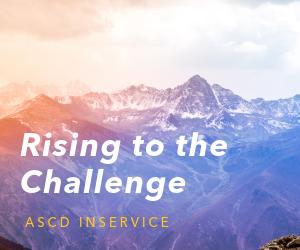Over the last decades, educators have increasingly questioned traditional models of schooling: The teacher as dispenser-of-knowledge, desks in rows, siloed curricula, and assessments of trivial knowledge. They know the best schools should work to closely involve families and communities, to give all students access to a variety of post-secondary options, and to awaken the joy of learning. But that last part—joy—has been an undervalued and overlooked part of school evaluation and practice, particularly at the secondary level. To bring it back, leaders will need to nurture significant change.
When we are young children, for most of us, joy is obvious. Curiosity and questions abound. And as adults, we often love to learn things we are interested in; learning is connected to our lives, our jobs, our interests. I once took an introductory flight lesson as a young teacher to show my class the math and physics of flight. I couldn’t get over the feeling that humans had figured out how a hunk of fiberglass and metal could, with enough lift and thrust, carry people into the clouds.
Somehow, though, in between early childhood and adulthood, we extinguish the joy of learning and replace it with drudgery. We replace curiosity with “standardization.” We give students fewer choices about what they study, insisting instead that they all master the same material at the same time. We reward compliance more than creativity. The worst part is that we often accept the absence of joy as a necessary evil of schooling.
A Growing Problem
Humans are wired to be curious and want to learn, but the rigid structure, mandatory curriculum, and standardized testing that rules today, particularly in secondary schools, often extinguish natural creativity and curiosity. Yale University researchers surveyed over 20,000 high school students and determined that more than 75 percent had negative feelings about school; it made them feel “tired, stressed, and bored.”
I see this lack of joy up close as an education leader: In my district in Long Island, New York, at the secondary level, joy is absent in students who are taking diploma-required classes that don’t seem relevant to them. I see the most engagement among students who are studying topics that interest them—in orchestra classes, science-research programs, the auto shop, and the art room. I can tell from their enthusiasm which students love history and which mathematicians-in-training see beauty in numbers.
School leaders need the courage to look for real solutions that reinfuse joy and curiosity into learning at the secondary level.
Part of the problem with schooling today stems from standardized testing. In New York State, for example, the Global History Regents examination from 2022 required students to make sense of questions with obscure language like, “The Ottoman social clockwork does not begin to exhaust its fractal intricacy.” This year’s Earth Science exam started with the question, “Which two characteristics classify Jupiter as a Jovian planet?” Even if questions like these are answerable, why are they necessary? Not only have these exams driven the definition of student success, but they have also been part of our teacher evaluation system. Teachers who wanted to stray from the rigid curriculum and let students have more voice and choice in their learning risked both students’ success and their own careers.
Another way this disengagement shows up is in student attendance. There are many reasons why students don’t come to school, but we should recognize lack of meaningful learning as a contributing factor. Even prior to the pandemic, around 20 percent of the nation’s high school students were considered chronically absent, according to the U.S. Department of Education. The pandemic accelerated this dramatically. If schools don’t teach things that matter, students will increasingly decline to connect.
School leaders need the courage to look for real solutions that reinfuse joy and curiosity into learning at the secondary level. We would be wise to consider several new directions in making school matter to students.
Identify an essential core of knowledge that all high school graduates need to know well.
Until 1900, human knowledge doubled every 100 years or so, according to Buckminster Fuller’s theory of the knowledge-doubling curve; now theorists estimate human knowledge doubles about every 12 hours. As the knowledge base increases, the span of useful knowledge decreases, replaced with new information.
Schools need to be cognizant of these processes and change the core body of required knowledge to a much more basic one. For example, I would argue that successful adults need to:
- Be able to read, write, and speak effectively.
- Be fluent in basic math (many adults don’t use trigonometry or calculus in daily life).
- Have a big-picture view of science and history.
- Be able to find and evaluate knowledge effectively.
By narrowing the 'necessary' and broadening the 'possible,' we can increase student voice and choice in learning.
Once students master these basics, they should be able to customize their experiences with work that matters to them. Conducting and documenting original research or participating in workplace internships provides in-depth learning experiences that mimic real life. By narrowing the “necessary” and broadening the “possible,” we can increase student voice and choice in learning. As school leaders, we need to continue to push for changes and flexibility in local and state assessments and knowledge requirements.
Revamp curricula to be more relevant.
In history, students still focus on ancient times and have only a cursory understanding of how modern governments function. They also have little geographic knowledge—a critical understanding for our smaller-than-ever world where people communicate globally. History needs to move away from trivia; students do not need to know from memory who fought Rome in the Punic Wars. They need a big-picture understanding of historical themes and events, with a focus on how those events have influenced the modern world. Essential questions and overarching themes help students to see the “why,” which makes learning more relevant and engaging.
And though science instruction has made tremendous strides in using hands-on experiments instead of rote memorization, every student should have more chances to conduct original research, analysis, and reporting. Science textbooks are outdated the moment they go to print; let’s get students reading scientific journals and learning about modern scientific developments. In my district, we are planning a marine science laboratory built on the bay, where our students can conduct high-level experiments with flow-through water tanks, a boat dock, and direct water access.
Support post-secondary training and employment as equally as college.
Though college graduation rates vary by state, data from the U.S. Department of Education makes clear that many high school graduates expecting to finish college struggle to do so. A long list of careers that don’t require a college degree are predicted to remain in demand—electricians, medical assistants, firefighters, wind turbine technicians, and computer technicians among them. In my district, leaders have plans for developing alternative models of high school—including more career-preparation program pathways, opportunities for students to choose classes more aligned to their aspiring career goals, and online and evening class options—which hopefully will enable students to see real choices in their studies. We are also adding more vocational programs in aquaculture and marine technology, which are growing and relevant fields on our barrier island.
By encouraging students to pursue their occupational interests enthusiastically, we can free students (and parents and caregivers) from the thinking that the only path to success is a four-year college degree, eliminating the often-exorbitant debt that accompanies that pathway.
Agency Over Compliance
All students deserve voice in their studies and should be able to see that what they are doing from 8:00 a.m. to 3:00 p.m. matters. By making changes to schools to ensure that students have choices—and thus, more satisfaction—leaders can support students’ present well-being and future success, and replace compliance with joy in learning. Our children need us to be visionary leaders, not educators of a school structure that was built for a world of the past.








